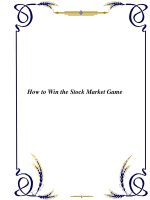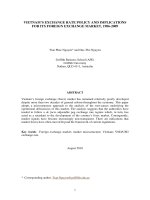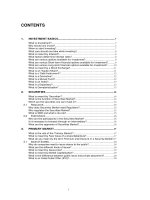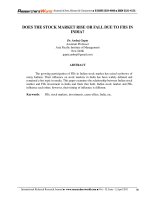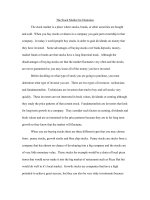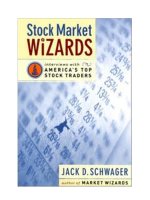Seasonal stock market trends (2009)
Bạn đang xem bản rút gọn của tài liệu. Xem và tải ngay bản đầy đủ của tài liệu tại đây (5.02 MB, 317 trang )
(continued from front flap)
$60.00 USA/$66.00 CAN
KAEPPEL
JAY KAEPPEL is a successful trading strategist for
Optionetics, Inc., and is actively involved in developing
new trading-related products. He pens a weekly column
titled “Kaeppel’s Corner,” in which he writes on a
variety of trading topics for www.Optionetics.com.
A former Commodity Trading Advisor (CTA), Kaeppel
has over twenty years of trading, writing, system
development, and programming experience, and is
the author of The Four Biggest Mistakes in Futures
Trading, The Four Biggest Mistakes in Option Trading,
and The Option Trader’s Guide to Probability, Volatility,
and Timing (Wiley). He has also developed a variety of
award-winning futures and options software programs
and published dozens of articles in Technical Analysis
of Stocks & Commodities and Active Trader magazines.
For more information on Jay and his works, visit
www.seasonaltrades.com.
Jacket Design: Brian Boucher
SEASONAL STOCK
MARKET TRENDS
“Seasonal Stock Market Trends is by far the most comprehensive
analysis of seasonality since we created the Stock Trader’s
Almanac forty-two years ago. We even learned a few new
things.”
-—Jeffrey and Yale Hirsch,
Creators and Editors at Large,
Stock Trader’s Almanac and www.stocktradersalmanac.com
“Jay Kaeppel’s book, Seasonal Stock Market Trends, sets a new
standard in seasonality research. There is no guessing here; all
of his work is well researched and thoroughly tested.”
-—David Vomund, President,
Vomund Investment Management
“Jay Kaeppel is a highly regarded market analyst who brings
his discerning perspective to the study of seasonal patterns in
the stock market. In this comprehensive text, Kaeppel builds
on the vast literature of calendar price tendencies and goes
on to develop a wealth of powerful new seasonal investment
strategies.”
-—Nelson Freeburg, Editor,
Formula Research
SEASONAL STOCK MARKET TRENDS
Seasonal Stock Market Trends will help you incorporate
seasonal trends into your current investment or
trading endeavors and put you in a far better position
to generate consistent profits over time. Free of
complicated trading systems and so-called surefire
secrets, this book will set you on a solid path to finding
opportunities in the markets based on recurring
seasonal patterns.
Praise for
THE DEFINITIVE GUIDE TO CALENDAR-BASED STOCK MARKET TRADING
Rounding out this detailed discussion is a chapter
devoted to using a variety of seasonal trends to build
three separate investment models—the Long-Only
Method, the Long-Only Plus Leverage (LOPL)
Method; and “Jay’s Ultimate Seasonal Barometer”
(or JUSB). These detailed models are designed to
generate specific buy and sell signals, and require no
interpretation on your part.
SEASONAL
STOCK
MARKET
TRENDS
THE DEFINITIVE GUIDE TO
CALENDAR-BASED
STOCK MARKET TRADING
JAY K A E PPE L
n many aspects of life, things occur in a repetitive
pattern. And while things do in fact change over
time, the basic underlying idea of seasons and
seasonality is that even though things do change, they
often return to a particular state over and over again—
often in a very predictable way.
I
Over the course of the past twenty-five years, author
Jay Kaeppel—one of the most experienced professionals in the areas of seasonality and stock, options, and
futures trading—has examined a wide range of seasonal
and cyclical trends as they relate to the stock market
over the past century. Now, with Seasonal Stock Market
Trends, he shares his extensive insights with you.
Written in a straightforward and accessible style, this
book will show you how following the calendar—and
taking advantage of consistently strong seasonal
trends—can help you to achieve long-term stock
market success. Kaeppel introduces you to a wide
array of seasonal stock market trends—most based
on 70 to 100 plus years of actual market data—and
identifies objective “rules” for utilizing each one. Along
the way, he also presents a process that allows you to
track the performance of a given strategy, so that you
can gauge its overall effectiveness.
Just a few of the trends touched upon include:
•
Holiday Seasonal Trends, which looks at the trading
days surrounding market holidays to reveal some
surprising results
•
Monthly Seasonal Trends, which focuses on a variety of
intramonth market trends and breaks the month
down into clearly defined favorable and unfavorable
trading days
•
Repetitive Time Cycles of Note deals with the
performance of the stock market in relation to
three specific, and repetitive, time cycles—the
212-week cycle, the 40-week cycle, and the
53-day cycle
•
Sell in May and Go Away thoroughly analyzes the
advantages and disadvantages of breaking the year
into two six-month periods for investment purposes
(continued on back flap)
P1: JYS
FM
JWBT009-Kaeppel
November 8, 2008
9:51
vi
Printer: Courier Westford
P1: JYS
FM
JWBT009-Kaeppel
November 8, 2008
9:51
Printer: Courier Westford
Seasonal
Stock Market
Trends
i
P1: JYS
FM
JWBT009-Kaeppel
November 8, 2008
9:51
Printer: Courier Westford
Founded in 1807, John Wiley & Sons is the oldest independent publishing company in the United States. With offices in North America, Europe,
Australia, and Asia, Wiley is globally committed to developing and marketing print and electronic products and services for our customers’ professional and personal knowledge and understanding.
The Wiley Trading series features books by traders who have survived
the market’s ever changing temperament and have prospered—some by
reinventing systems, others by getting back to basics. Whether a novice
trader, professional, or somewhere in-between, these books will provide
the advice and strategies needed to prosper today and well into the future.
For a list of available titles, visit our web site at www.WileyFinance.com.
ii
P1: JYS
FM
JWBT009-Kaeppel
November 8, 2008
9:51
Printer: Courier Westford
Seasonal
Stock Market
Trends
The Definitive Guide
to Calendar-Based
Stock Market Trading
JAY KAEPPEL
John Wiley & Sons, Inc.
iii
P1: JYS
FM
JWBT009-Kaeppel
Copyright
C
November 8, 2008
9:51
Printer: Courier Westford
2009 by Jay Kaeppel. All rights reserved.
Published by John Wiley & Sons, Inc., Hoboken, New Jersey.
Published simultaneously in Canada.
No part of this publication may be reproduced, stored in a retrieval system, or transmitted in
any form or by any means, electronic, mechanical, photocopying, recording, scanning, or
otherwise, except as permitted under Section 107 or 108 of the 1976 United States Copyright
Act, without either the prior written permission of the Publisher, or authorization through
payment of the appropriate per-copy fee to the Copyright Clearance Center, Inc., 222
Rosewood Drive, Danvers, MA 01923, (978) 750-8400, fax (978) 646-8600, or on the web at
www.copyright.com. Requests to the Publisher for permission should be addressed to the
Permissions Department, John Wiley & Sons, Inc., 111 River Street, Hoboken, NJ 07030, (201)
748-6011, fax (201) 748-6008, or online at />Limit of Liability/Disclaimer of Warranty: While the publisher and author have used their best
efforts in preparing this book, they make no representations or warranties with respect to the
accuracy or completeness of the contents of this book and specifically disclaim any implied
warranties of merchantability or fitness for a particular purpose. No warranty may be created
or extended by sales representatives or written sales materials. The advice and strategies
contained herein may not be suitable for your situation. You should consult with a
professional where appropriate. Neither the publisher nor author shall be liable for any loss of
profit or any other commercial damages, including but not limited to special, incidental,
consequential, or other damages.
For general information on our other products and services or for technical support, please
contact our Customer Care Department within the United States at (800) 762-2974, outside the
United States at (317) 572-3993 or fax (317) 572-4002.
Wiley also publishes its books in a variety of electronic formats. Some content that appears in
print may not be available in electronic books. For more information about Wiley products,
visit our web site at www.wiley.com.
Library of Congress Cataloging-in-Publication Data:
Kaeppel, Jay.
Seasonal stock market trends : the definitive guide to calendar-based stock market trading /
Jay Kaeppel.
p. cm.
Includes index.
ISBN 978-0-470-27043-1 (pbk.)
1. Stocks–Charts, diagrams, etc. 2. Investment analysis. 3. Investments. I. Title.
HG4638.K34 2009
332.63 22–dc22
2008036344
Printed in the United States of America.
10
9
8
7
6
5
4
3
2
1
iv
P1: JYS
FM
JWBT009-Kaeppel
November 8, 2008
9:51
Printer: Courier Westford
To Maggie, Jenny, and Jimmy
v
P1: JYS
FM
JWBT009-Kaeppel
November 8, 2008
9:51
vi
Printer: Courier Westford
P1: JYS
FM
JWBT009-Kaeppel
November 8, 2008
9:51
Printer: Courier Westford
Contents
Preface
xi
CHAPTER 1 Introduction to Seasonality in the
Stock Market
1
The Concept of Seasons and Seasonality
2
What Is Seasonality?
5
The Pioneers of Stock Market Seasonality
7
Measuring Market Performance throughout This Book
9
How to Trade the Dow
11
Seasonal Trends to Consider
14
Summing Up
18
CHAPTER 2 The Month of January
21
The First Five Days of January
22
The Last Five Days of January
25
The January Barometer
27
The January Barometer as a Stand-Alone System
29
The JayNewary Barometer
31
The Ultimate January Barometer System
38
The Effect of Compounding
42
A Few Words of Warning
46
Summing Up
47
CHAPTER 3 Holiday Seasonal Trends
49
The Holidays
50
The Trading Day before Each Holiday
51
Two Days before Each Holiday
52
vii
P1: JYS
FM
JWBT009-Kaeppel
November 8, 2008
9:51
Printer: Courier Westford
viii
CONTENTS
Three Days before and after Each Holiday
54
The Best Holiday Trading Days
56
The Ultimate Holiday System
61
The Most Wonderful Week of the Year (Usually)
63
Summing Up
65
CHAPTER 4 Monthly Seasonal Trends
67
The Best Day of the Month
68
The Trading Days of the Month
71
The Worst Trading Days of the Month
80
The Best Trading Days of the Month (Part 1)
81
The Best Trading Days of the Month (Part 2):
The Month-End/New-Month Pattern
83
The Most Wonderful Time of the Year
89
Monthly 10 Combined with the Santa Claus Rally
91
The Ultimate Monthly Days System
93
One Last Tweak
96
Summing Up
100
CHAPTER 5 Yearly Seasonal Trends
103
Decennial Patterns (Part 1: Ranking the Years)
104
Decennial Patterns (Part 2: The Best and Worst Years)
106
Decennial Patterns (Part 3: The Decennial Road Map)
110
Decennial Tendencies
111
Decade-by-Decade Performance
112
Intradecade Trends of Note
123
Intradecade Cycles Combined
130
Summing Up
136
CHAPTER 6 Repetitive Time Cycles of Note
139
The 212-Week Cycle
140
The 40-Week Cycle
146
The 53-Day Cycle
153
Combining Cycles
163
The Ultimate Time Cycles Model
168
Summing Up
172
P1: JYS
FM
JWBT009-Kaeppel
November 8, 2008
9:51
Printer: Courier Westford
Contents
ix
CHAPTER 7 Election Cycle Investing
173
The Election Cycle: By the Years
175
The Election Cycle: By the Months
187
Two Other Patterns in the Election Cycle
205
The Ultimate Election Cycle System
210
Summing Up
214
CHAPTER 8 Sell in May and Go Away
219
November to May
220
What Is MACD?
225
Using MACD as a Filter
227
October through June for the Nasdaq
238
The Dead Zones
246
The Easiest Market-Beating Strategy in the World
260
October of Year 7
261
Summing Up
264
CHAPTER 9 Putting It All Together
267
Building Seasonal Trading Models
268
Building the KTI
271
Comparing Extreme KTI Readings
273
Model 1: The Long-Only Method
276
Model 2: The Long-Only Plus Leverage (LOPL) Method
278
Model 3: Jay’s Ultimate Seasonal Barometer
281
Summing Up
284
Index
291
P1: JYS
FM
JWBT009-Kaeppel
November 8, 2008
9:51
x
Printer: Courier Westford
P1: JYS
FM
JWBT009-Kaeppel
November 8, 2008
9:51
Printer: Courier Westford
Preface
t was just about the dumbest thing I’d ever heard. And I remember it as
plain as day. Like a lot of ideas that have come and gone over the years,
I don’t even remember the source, sadly. But the message was simple—
the stock market was soon to embark on a major bull market, rising to new
all-time highs in the process. It was a preposterous notion.
The time was April 1982. For the previous 16 years, the Dow Jones
Industrial Average had fluctuated in a wide range between 1,051 on the
upside and 578 on the downside. The Dow had approached or exceeded
the magical 1,000 level on five occasions, always to be turned back. There
had also been a series of painful bear markets during this 16-year stretch.
The bear market of 1966 ended with the Dow plunging 969 to 744, down
23 percent in a little more than nine months. The 1969–1970 bear market
was a near replay, with the Dow shedding 36 percent from its bull market high. The 1973–1974 bear market was the worst since the Great Depression. From peak to valley, the Dow fell a staggering 45 percent, and
the combination of high inflation and deflated stock prices—not to mention the Watergate scandal—took a powerful toll on investors’ psyches.
Following a 75 percent advance from the December 1974 low to the
September 1976 high, the Dow experienced another decline of 27 percent
between September 1976 and February 1978. Over the next 38 months, the
Dow again advanced back above 1,000, peaking at 1,024 in April 1981. And,
as investors had come to expect, the rally failed to hold. By March 1982,
the Dow was back under 800, 22 percent off of the April 1981 high.
So there I was, a neophyte in the market, learning the lessons of the
market. The conventional wisdom at the time was pretty straightforward:
I
r The Dow trades in a range between roughly 600 and 1,050.
r Whenever it approaches 1,000, it is time to keep an eye on the exits,
because the stock market always tops out when it nears that level.
r It is a given that the stock market declines during a post–presidential
election year. Within the 16-year trading range, the Dow lost ground
in 1969 (15 percent), 1973 (16 percent), 1977 (17 percent), and 1981
xi
P1: JYS
FM
JWBT009-Kaeppel
xii
November 8, 2008
9:51
Printer: Courier Westford
PREFACE
(9 percent). So looking ahead, it was pretty much a sure thing that
1985 would be a bad year for stocks.
r The good news of the day was that the stock market always makes a
low every four years. The years of 1962, 1966, 1970, 1974, and 1978 had
all witnessed a meaningful multiyear low.
So, sitting there in April 1982, with the Dow roughly 20 percent off of
its April 1981 high, investors might have felt confident that a multiyear low
was in the offing. Unfortunately, at the time, everyone knew that things
were different this time around. Ronald Reagan had been in office a little
more than a year, and despite the fact that he had promised to lower inflation and get the economy going, inflation and interest rates were still high
(albeit declining), the economy was still struggling, and some of the leading stock market advisers of the day were extremely bearish. In fact, Joe
Granville, who had called the 1981 top almost exactly—clearly a man with
his finger on the pulse of the market—was forecasting another economic
depression. So, when I stumbled upon a tidbit of cyclical stock market history, I almost had to laugh.
As I mentioned earlier, I don’t recall where I read it. But, wherever it
came from, this piece pointed out that the stock market had staged strong
rallies between the end of June of years ending in 2 and the end of December of years ending in 5—get this—every other decade. In other words, we
were supposed to care that between June 1902 and December 1905, the
Dow had rallied 50 percent and that, 20 years later, between June 1922 and
December 1925, the Dow had rallied 69 percent. And, it was supposed to
hold some historical significance that between June 1942 and December
1945, the Dow had advanced 87 percent and that, another 20 years later,
the Dow had rallied 73 percent between June 1962 and December 1965.
In a nutshell, we were supposed to believe that what had happened
in the stock market 20, 40, 60, and 80 years prior somehow mattered a
hoot in the present day. What a hoot, indeed. And we were also to ignore
the fact that this trend from June of years ending in 2 through December
of years ending in 5 only worked every other decade. In other words, this
pattern did not necessarily work from 1912 to 1915, from 1932 to 1935, from
1952 to 1955, and from 1972 to 1975. To put it mildly, I did not put much
faith in this little nugget of stock market history, especially with a leading
expert like Joe Granville predicting a depression. Nevertheless, because I
was still learning the ropes in the stock market, I tried to keep track of as
many market tools as possible. With a chuckle, I wrote, “Every 20 years
between June of year 2 and December of year 5 indicator” into my log of
stock market tools. Then I quickly turned my attention back to more useful
tools, like economic and earnings forecasts.
P1: JYS
FM
JWBT009-Kaeppel
Preface
November 8, 2008
9:51
Printer: Courier Westford
xiii
On June 30, 1982, after the stock market closed, I wrote down the level
of the Dow: 811.93. This was just 2 percent above its recent low of 796,
achieved a few months earlier during March. By August 12, 1982, the Dow
had drifted lower to 776.92, its lowest level in more than 28 months. With
the weight of negative economic and market forecasts still hanging heavy,
this new low appeared to be a strong confirmation that investors needed to
brace themselves for a continuing stock market decline. Then something
strange happened.
Over the subsequent two days, the Dow staged a respectable 2 percent gain. Then, on August 16, 1982, something inexplicable happened. The
stock market rallied 4.9 percent, in one day. And from there, it never looked
back. About a month later, the Dow stood 20 percent above its August low.
Some investors leaped aboard the soaring rocket ship that the stock market
had suddenly become. Most others stood by with their collective jaws on
the floor, unable to pull the trigger in the face of a market reality completely
at odds with the conventional wisdom, or such as it was just a month prior.
On June 30, 1982 (i.e., at the end of June of year 2 of an even-numbered
decade), the Dow stood at 811.93. And 36 months later, on December 31,
1985 (i.e., at the end of December of year 5 of an even-numbered decade),
the Dow stood at 1,546.67. This represented a gain of 99 percent in just two
and a half years. By that time, a cyclical analyst had been born.
Over the past 25 years, I have examined in great detail a wide range of
seasonal and cyclical trends as they relate to the stock market. Much of the
best of what I have learned is contained in the following pages. The cycle
marking June of year 2 through December of year 5 has been refined somewhat and appears in Chapter 5 as the cycle of October of year 2 through
December of year 5. I have written in the past about some of the discoveries I have made. In many cases, those discoveries amount to things that
other analysts have already learned and made public. Some of the pioneers
of seasonal stock market analysis are noted in Chapter 1 and throughout the book as the ones who deserve credit for a particular finding. In
Technical Analysis magazine, I have published articles such as, “The January Barometer: Myth or Reality” (discussed in Chapter 2), “The 40-Week
Cycle in the Stock Market” (discussed in Chapter 6), and “The Stock Market, the Calendar, and You,” which incorporated a variety of seasonal
trends into one comprehensive market-timing model.
Numerous studies have shown that the greatest influence on the price
action of any given stock is the action of the overall stock market. A rising tide lifts all boats. In the stock market, it is a similar story. Whereas a
bullish stock market in no way ensures that all stocks will participate, it
is easier to make money in stocks when the overall market is rising than
when it is falling. Likewise, it is often best to invest defensively, or perhaps even raise some cash, if the prospect for an overall decline in stock
P1: JYS
FM
JWBT009-Kaeppel
xiv
November 8, 2008
9:51
Printer: Courier Westford
PREFACE
prices is great. The material presented throughout this book is designed to
help investors weigh the likelihood of an overall stock market advance or
decline during a particular time frame.
The most important thing that you can do in analyzing and considering
the research presented in this book is to read with an open mind. As I described at the outset, the easiest thing to do is to laugh off ideas that seem
to have no foundation in fundamental analysis, be they related to earnings
and sales or supply and demand. What people think about what the stock
market will do next and why has no real bearing on what the stock market ends up doing. The methods and tools presented herein provide a very
useful road map for investors who seek to maximize their long-term profitability by using all tools at their disposal.
JAY KAEPPEL
P1: JYS
FM
JWBT009-Kaeppel
November 8, 2008
9:51
Printer: Courier Westford
Seasonal
Stock Market
Trends
xv
P1: JYS
FM
JWBT009-Kaeppel
November 8, 2008
9:51
xvi
Printer: Courier Westford
P1: JYS
c01
JWBT009-Kaeppel
November 1, 2008
14:1
Printer: Courier Westford
CHAPTER 1
Introduction to
Seasonality in
the Stock Market
ithin nature there exists an undeniable ebb and flow. The sun unfailingly rises in the east and then sets in the west. The moon revolves around the earth. The earth revolves around the sun. Trees
grow leaves in the spring. The leaves turn bright colors in the fall and by
winter they have fallen to the ground. The following spring the same routine starts anew. Most people go to bed at night and rise in the morning.
What happens in nature affects humans, not only physically, but also emotionally and psychologically. Thunderstorms instill fear and a desire to seek
shelter. A blizzard triggers an urge in people to hunker down and cocoon
at home under a blanket. A dark, dreary day has an undeniable tendency
to cause many people to experience—for lack of a better word—a funk,
a state of mind in which virtually nothing feels right. But, ah, a warm,
sunshine-filled day can all by itself suddenly make everything feel right.
For millennia, the human race was a slave to the sun. And, to this day, people are drawn to bask in its glow. To better understand this phenomenon,
picture opening the drapes first thing in the morning on a cloudless, sunny
day following three days of dreary weather. Suddenly, almost magically,
the darkest of moods seem to melt away.
So, what does any of this have to do with the stock market? The heart
of the matter comes down to the fact that humans are a creature of habit
and repetition, and that many, many things in life happen on a cyclical basis. And these cycles can greatly affect the way a person thinks or feels.
Let’s first consider the concept of seasons.
W
1
P1: JYS
c01
JWBT009-Kaeppel
2
November 1, 2008
14:1
Printer: Courier Westford
SEASONAL STOCK MARKET TRENDS
THE CONCEPT OF SEASONS AND
SEASONALITY
Virtually everyone is familiar with the concept of a season. We can start
with winter, spring, summer, and fall. Add in hunting season, football season, mating season, hurricane season, holiday season, and so on. Factor in
“a season for all things,” “now is the season of our discontent,” “the seasons
changed and so did I,” and you start to get the idea.
In a nutshell, in many aspects of life things occur in a repetitive pattern.
Spring follows winter, then summer, fall, and then winter again. Things do
in fact change over time. Yet, the basic underlying idea of seasons and seasonality is that although things do change, they often return to a particular state over and over again—often in a very cyclic and predictable way.
Over time, the human mind comes to understand the cyclic or seasonal
nature of certain occurrences and begins to adapt. In the old days in coldweather climates—before the advent of heat and running water—humans
used to gather up provisions as the fall progressed to ensure that there
would be enough food to last the winter. Nowadays, many individuals
in cold-weather climates use the beginning of baseball spring training in
February as something to latch onto to help get them through the remaining cold months of winter and to remind them that better (or at the very
least, warmer) days are certainly ahead. Today, many people living along
the Atlantic Ocean or the Gulf of Mexico make preemptive plans regarding
the potential for hurricanes during the late summer and fall months.
So what, you might ask, does any of this have to do with the stock
market? I mean, certainly, one might be willing to grant the notion that
weather-related seasonal trends could have an impact on commodities and
grains. Things that grow in the ground or that eat the things that grow in
the ground clearly can be affected if the ground is too wet or too dry (or
covered with three feet of snow) and does not allow for the normal planting
process to proceed. But the stock market is primarily based on financial
assets, not physical assets. As long as the New York Stock Exchange has
electricity, the nature of the weather outside is seemingly irrelevant. And
the Nasdaq market doesn’t even operate a physical exchange. So, here too,
the vagaries of weather and seasons would at first blush seem to be quite
irrelevant. But the reality is that there is more to cyclicity, seasons, and
seasonality than mere weather.
In many cases, seasons become a state of mind. As I have already described, in many instances, people prepare for certain recurring events,
proceed as planned during the period in question, and then relax and redirect their energies in different directions once the anticipated cyclic or seasonal period or event has passed. In summary, human emotion becomes
intertwined with cyclical trends.
P1: JYS
c01
JWBT009-Kaeppel
November 1, 2008
14:1
Introduction to Seasonality in the Stock Market
Printer: Courier Westford
3
So, to sum up so far, we all accept the fact that many things in life
are seasonal in nature, or cyclic. Most of us recognize and accept the notion that people’s thoughts, attitudes, and emotions can change with the
seasons. This is an important connection, because the stock market can
be thought of as the ultimate arbiter of human emotion as it relates to all
things financial.
It can be argued that the stock market experiences seasons or cycles.
At the very least, one can make the case that there are bull seasons, when
the stock market advances, and bear seasons, when the stock market declines. In addition, one could argue that there are at least two or three other
seasons in the stock market:
r A pullback in a longer-term bull market.
r A rally in a longer-term bear market.
r An extended trendless period.
Although none of these seasons are related to weather and although
bull markets and bear markets certainly cannot be counted on to always
begin and end on the same dates each year, the fact remains that these
seasons are a fact of life for stock market investors. As such, most investors
ultimately have to learn to deal with the inevitable change of seasons in the
stock market.
Whereas many individuals try to deal with these seasons as objectively
as possible, ultimately, much of the decision-making process comes down
to emotion. As a result, the gyrations of the stock market have a direct
relationship with human emotion that is deeply intertwined. At times, the
fluctuations of the stock market can cause mass changes in the overall
emotional state of market participants. Likewise, at other times, the emotional state of market participants as a whole can exert a direct effect on
the direction of stock prices. In essence, what happens over time is that the
season for investors moves from greed to complacency to fear, and then
the process repeats. To better understand this change of seasons, let’s consider a typical stock market cycle and how it affects investors’ thinking and
vice versa.
The initial stages of a bear market are generally marked by denial, as
investors who have become used to making money can’t bring themselves
to believe that the good times have come to an end. As the bear market unfolds, more and more investors eventually bail out—often swearing never
to risk their hard-earned money again—whereas others cling to every countertrend rally, hoping that it is the start of the next bull market. As the bear
market reaches its low, fear typically ramps up and ever more people decide they can’t stand the pain of losing money anymore. At a major stock
P1: JYS
c01
JWBT009-Kaeppel
4
November 1, 2008
14:1
Printer: Courier Westford
SEASONAL STOCK MARKET TRENDS
market bottom, there is typically great despair among investors. And, at
about this time, the season changes. The stock market no longer continues
to make new lows but, in fact, may stage a strong rally off of a low. With
human nature being what it is, many investors refuse to believe that the
bottom is in. And, they refuse to be sucked into the market once again in
fear that another plunge is in the offing. But, even as these former investors
stand aside and get left behind, the season is changing back from bearish to
bullish. As the bull market continues, optimism grows and investors flock
back to the market, looking to make their money grow. Eventually, concerns of downside risk give way to fears of missing out, and money pours
into stocks of all stripes and colors. As optimism and complacency reach
their peak, the stock market tops out once again. It is often said that the
masses are right in the middle and wrong at the extremes. In other words,
the majority of investors are typically too bullish at the top and too bearish
at the bottom. And, in my experience, this adage has proved to be true.
One of the key factors that drives emotion when it comes to investing
is the fact that it involves the potential increase—or decrease—in one’s
hard-earned money. Making or losing a lot of money quickly tends to have
strange effects on people. For example, in most instances, people prefer to
buy something when the price is lower. If an item cost $20 yesterday and
today costs only $18, most people will be more attracted to that item today
on the basis that it now represents a better value than it did yesterday.
When that item comes to the stock market, however, this is not always the
case. This is partly because no one can ever be sure how low is low. In
other words, it is possible for the stock of a given company to go to zero
if the company goes bankrupt or out of business. The fear of this potential
outcome always lingers in the back of investors’ minds. And, as a result, a
decline in the price of a stock more often is likely to persuade someone to
sell that stock than it is to persuade someone to buy it. In other words, the
thinking eventually changes along the following lines.
I bought it at $22 because I thought it was a value. At $20 I figured it
must be an even better value so I bought some more. At $18 I started to
wonder whether maybe my analysis was a bit early in selecting this stock
as a value. At $16 I started to think seriously about cutting my losses. By
the time the stock reached $14, I couldn’t take it anymore and decided to
bail out. As the stock hit $10 a share, I realized that it was one of the biggest
dog companies to ever exist so I decided to sell it short. Three days later, it
was back over $14 and I finally realized that I had no idea what I was doing.
And, so it goes. In some ways, buying a stock can be viewed along
the lines of finding a mate. Investors first identify and become involved
with an attractive stock. But, as happens sometimes, things go south. As
the price of the stock declines, investors first attempt to remain convinced
that the stock is attractive. Eventually, investors realize that this mate is
P1: JYS
c01
JWBT009-Kaeppel
November 1, 2008
14:1
Introduction to Seasonality in the Stock Market
Printer: Courier Westford
5
trying to take them for all they are worth. Painfully, investors accept the
fact that they were wrong and that they must terminate the relationship.
After that comes the remorse and recriminations. Now, clearly this cycle
does not play out just this way with every stock purchase (nor, thankfully,
with every relationship). Still, it only takes one or two of these types of
experiences for the pain associated with them to be permanently seared
into an investor’s psyche. And, this memory can strongly affect the way
one looks at other future relationships.
Investors who suffer a loss beyond what they had expected will typically be gun shy for a good long while into the future, as they do not wish
to repeat this unpleasant experience. They may find themselves bailing out
of positions at the first sign of trouble, only to then find themselves on the
sidelines when the rally starts in earnest. Likewise, investors who achieved
a quick profit and then watched it vanish, never to return, may be very quick
to take profits in the future. These are just two simple examples of how the
market can affect an investor’s thinking, and how that thinking can affect
the actions that take place in the stock market. Clearly, investors’ moods
and outlooks change as the investment season changes. And, just as clearly,
changes in the moods and outlooks of the majority of investors can affect
the investment season.
So is it that much of a stretch to believe that the stock market
could have seasons? That is the question that this book will attempt to
answer.
WHAT IS SEASONALITY?
The Merriam-Webster online dictionary defines the words “season” and
“seasonal” as follows:
Season: a period characterized by or associated with a particular activity or phenomenon.
Seasonal: of, relating to, or varying in occurrence according to the
season.
For our purposes, we will use the word “seasonality” to define any
number of seasonal trends that seem to exist in the stock market. We
will define the phrase “seasonal trend” as a recurrent period characterized by certain occurrences—most notably, a tendency for the stock market to rise (or fall) in price. The seasonal trends that I will detail in this
book will be outlined in a moment. For now, let’s define what seasonality
is not.
P1: JYS
c01
JWBT009-Kaeppel
6
November 1, 2008
14:1
Printer: Courier Westford
SEASONAL STOCK MARKET TRENDS
You must accept the fact that seasonality in the stock market is not a
magic formula. Throughout this book we will be looking at a variety of seasonal trends, each with specific buy and sell dates. And, as you will see, the
results for many of these seasonal trends have accumulated an extremely
impressive track record. And, to some individuals, it might seem to make
sense to use these trends on a systematic basis. But that is a determination
that each investor must make on his or her own. In the end, the goal of this
book is to convince you that seasonality has a place in your investment
strategy. However, the goal is not necessarily to try to convince you that
you should rely solely on seasonal tendencies to the exclusion of all other
analyses.
The best analogy that I have heard for describing the proper way to
look at seasonal trends in the financial markets came from Michael Santoli
in his Barron’s Financial Weekly “Streetwise” column from November 26,
2007. In that particular column he stated the following:
“Seasonality is climate, not weather.”
Although this comment may not make intuitive sense to everyone, it
very accurately sums up the proper perspective that an investor should
have when considering incorporating seasonal trends into an investment
strategy. Just because it is December in Chicago does not necessarily mean
that the temperature will be extremely cold. On an unseasonably warm day,
the high in Chicago can reach above 50 degrees even during what is considered a winter month. Seasonality tells us that it should be cold, or more
accurately, that it is more likely than not to be cold on a December day in
Chicago, but the weather outside can vary widely. As we will see, the same
is true regarding seasonal trends in the stock market. If a given time of year
has been up 60 times in the past 70 years, we would intuitively look for that
period to be bullish again this year. But whether this year ultimately falls
into the normal bullish category or joins that smaller number of bearish
aberrations cannot be accurately predicted in advance.
So the bottom line is that seasonality in the stock market should not
be thought of as an exact science. Nevertheless, the other key piece of the
equation is to recognize from the data presented throughout this book the
powerful trends that seasonal patterns can help you to identify in the stock
market, and the fact that seasonal trends should not be ignored simply because they are not based on hard fundamental data such as earnings or on
a price-based technical indicator. In essence, a given seasonal trend is a
form of a psychological or sentimental indicator, as each seasonal trend is
a measure of the tendency of the investment masses to act in a certain way
in a certain repetitive form. Before jumping into the details of the actual
seasonal trends themselves, let’s first take a moment to recognize some of
the pioneers in the area of seasonally related research.
P1: JYS
c01
JWBT009-Kaeppel
November 1, 2008
14:1
Printer: Courier Westford
Introduction to Seasonality in the Stock Market
7
THE PIONEERS OF STOCK MARKET
SEASONALITY
Whereas some individuals will look questioningly upon the notion of seasonality in the stock market, the fact remains that some of the best minds
in the business have spent countless hours, and even years, conducting a
great deal of research in the area of seasonal trends in the stock market.
In the following text, I would like to give mention to a few of the early
pioneers in the area of seasonal stock market research.
Yale Hirsch
It might be appropriate to refer to Yale Hirsch as the “founding father” of seasonal trend analysis in the stock market. He was the
original editor and publisher of The Stock Trader’s Almanac (www.
stocktradersalmanac.com), which has been published annually since 1967.
As a result of countless hours of groundbreaking research, Hirsch became
the leading analyst in the area of historical stock market behavior and cycles in different political and economic environments.
His most notable contribution to the area of seasonality is the much
renowned January barometer. The premise underlying the January barometer is simply that as the month of January goes, so goes the entire stock
market year. This method is discussed in-depth in Chapter 2 along with
several variations. Other indicators that Hirsch has developed or popularized over the years are the Santa Claus rally (Chapter 4) and the best six
consecutive months of the year (Chapter 8). In summary, Hirsch’s research
over the years has helped many astute investors to profit in the stock market and has effectively served to legitimize the analysis of seasonal trends
in the stock market.
It should also be noted that Yale Hirsch’s son Jeffrey Hirsch has followed in his father’s footsteps and become another major player in the
area of research of seasonal market trends. Jeffrey is now the publisher of
The Stock Trader’s Almanac and authored The Almanac Investor: Profit
from Market History and Seasonal Trends (Wiley, 2005).
Norman Fosback
Norman Fosback authored the classic stock market book Stock Market
Logic in 1976. Fosback was and is a serious student of the market and
gained prominence in the 1970s and 1980s for implementing econometrics
in his stock market analysis. He edited a newsletter titled Market Logic
from 1975 until 1995. He also founded and was editor-in-chief of Mutual
